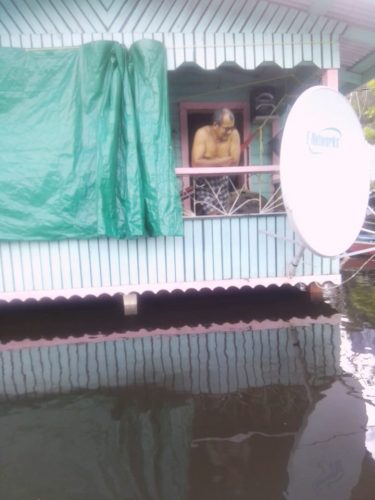As floodwaters continue to recede in Kwakwani and surrounding communities in Region Ten, regional health authorities are monitoring for water-borne diseases, Regional Chairman Deron Adams reported yesterday.
The chairman informed that medical teams have been dispatched to flood-hit communities to monitor and evaluate the situation on the ground.
“We are seeing a lot of dead rodents now as the water is dropping. So we are monitoring for water-borne diseases and cautioning residents in their movement,” he stated.

According to Adams, water levels have dropped between 33 to 43 inches in the community as rainfall has ceased.
He also explained that with many families suffering from losses due to the floods, a new list has been forwarded to the Civil Defence Commission (CDC) requesting assistance for items to aid families.
Adams noted that there is currently need for mattresses, mosquito nets, cleaning and hygiene supplies, water canisters and water purification tablets among other items. He also stated that they have requested a drone to assist in monitoring the damage and water levels in the flood-affected areas.
The CDC yesterday said that the water has dropped by approximately 18 inches in Kwakwani, Hururu, Sandhills, Dalawalla, and Landerville, however the bottom flats of homes as well as farmlands are still flooded with about four feet of water. In Maria Elizabeth, Muritaro, Malali, and Great Falls, water has dropped by approximately 3 to 6 inches, however, notwithstanding, water levels are still approximately three feet high with homes and farms are still flooded.
During the floods, water levels rose just over 14 feet and forced many families to evacuate.
Councillor of Region Ten, Elroy Adolph had told Stabroek News that shelters are still occupied and even though the water level is dropping, there is “still a lot of water on land.”
“They cannot move out of the shelters as of now because they have nowhere to go. The water is still high on the ground but it has dropped and we hope it continues to drop,” Adolph said.
Asked about food supplies and access to water, he responded that with donations pouring in from the private sector and government agencies, there is no immediate threat to food security. He noted too that the water treatment facility in the district has given all assurance of having an adequate amount of water in storage to serve the community.
“You know we are very thankful for all the assistance we are being given. We are truly grateful because we understand how difficult it is to help in a crisis. But we are extra thankful because people are finding means and ways to help us in a global crisis. We just have to say thanks,” he said.
With the severity of the floods, the Regional Councillor said that several residents have signalled their intention to move to higher ground and will like to commence construction soon after the flooding. He opined that a team from the Guyana Lands and Survey Commission should visit and execute a survey so as to determine the best possible area for development.




